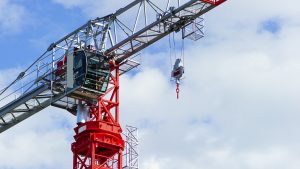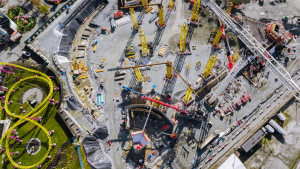Integrated Project Delivery (IPD) is a dramatic evolution on the horizon for the construction industry and Chamberlain Construction Services Limited finds itself at the forefront of that shift.
Integrated Project Delivery (IPD) is a dramatic evolution on the horizon for the construction industry and Chamberlain Construction Services Limited finds itself at the forefront of that shift.
“There’s a myth in the industry that design and construction are two separate processes and they’re not,” says founder and chief executive officer Brian Chamberlain.
“They’re totally interlinked and reliant one upon the other.”
Chamberlain has been using IPD for 25 years as a company, though Chamberlain notes the process was named only in the past few years.
The company is driven by owner-client service and IPD is its most effective process, which positions it as a leader in this area.
“It’s always cheaper, but the reason it works so well is that you maintain control over the project, you maintain flexibility all throughout the design and construction process,” he says.
“You have the owner, the architect and the constructor working together as a collaborative team, when there’s a challenge, there’s no finger pointing.”
Chamberlain was established as an architecture firm in 1978 and had been engaged in a lot of design-build work with a contractor who had been thinking of retiring. By 1981, Chamberlain had bought that already established construction company.
“I was sitting there at my then drafting board designing things and thinking ‘you know what? Architects know construction, but they don’t really know construction,’” he recalls.
“I thought it would make me a better architect if I knew construction more intimately.”
He served as site superintendent for two years during the construction of several of his projects, learning the business and about the jobs of construction management, estimating and site supervision.
“The design-bid-build process has serious faults and can result in less satisfactory outcomes for all parties,” he says.
“The silo nature of its contracts and relationships distances inter-reliant parties from one another. The bidding process does not produce the best building for the best price.”
Chamberlain says constructability is a very important issue in design since you can design details that would make a project difficult to build.
“Every time you make a design decision, you just made a dollar decision whether you like it or not.”
Having complete knowledge of the process ensures that when the design is complete and ready to go to market, there are no surprises when it’s time to find out how much money the various suppliers and trades want to construct the building.
“It’s very, very important that the architect, the constructor and the owner work together from the beginning so that you have that feedback loop of design, cost-check, re-design,
cost-check.”
The 3D technology of Building Information Modeling (BIM) can eliminate many uncertainties prior to starting construction of a project and it also requires a collaborative approach. Integrating BIM with IPD has revolutionized the way the company does business, says Chamberlain.
“When you take that information-rich BIM and you add it to the control and flexibility of IPD, it’s just the most efficient way of building a building.”
The company has used BIM exclusively for years but one of its problems with the system is that engineers are not as advanced in the process as his company’s staff, Chamberlain has found.
It’s much easier to run into conflicts with two-dimensional drawings, he adds.
“BIM allows us to first build the project virtually in cyberspace, rather than building the full scale structure on site at full cost. The initial model resolves conflicts before they show up on site.”
He pointed out that BIM is easier for clients to understand and it also reduces waste on site.
When Chamberlain first started using BIM, the company hired a BIM manager to introduce the system and process.
“Any of these new systems, be it AutoCad or BIM, it hurts for the first couple of years because you’re not very efficient at it,” he says.
“The learning curve is there, but once you start to get on it, it works.”
The company has developed “an aura of trust and respect that is essential to IPD,” describes Chamberlain. The designers, constructors, estimators and architects work side-by-side in the Chamberlain offices, creating that essential trust in the IPD process, he says.
Because of this atmosphere, the right attitude is the first thing Chamberlain looks for in workers.
“We identify the people that we think have the right attitude and secondly the people that have the passion for what we do. If you don’t have the passion for construction, then you should go do something else.”
The proper attitude is particularly important as there will always be difficulties when working on a construction project.
“There hasn’t been a construction project out there that hasn’t had challenges, but it’s how you handle those challenges. If you just throw up your hands and say ‘not my problem,’ that doesn’t speak to your character, but if you work diligently to solve the problem, that speaks to your character.”
Chamberlain began using IPD mainly in the commercial sector and then progressed into the public sector. It is here, Chamberlain says, that his company has been most successful in the last 10 to 15 years. The first public sector project the firm did was the over 10,200-square-metre Canadian Warplane Heritage Museum, which was constructed over 10 months with a final cost of $19 million.
He also notes cases in which IPD has helped them through challenges on site.
The Niagara-on-the-Lake fire hall and library was a 2,323-square-metre project and took 10 months to build
at a final cost of $3.5 million, approximately $247,000
under budget.
The masonry materials for the library proved to be a challenge and when Chamberlain began construction and issued the tender package, the masonry prices were over budget.
“We solved it between the owner, architect and the constructor. We didn’t delay the project and at the end of the day we weren’t over budget.”
The project also ran into a challenge when they were putting in the main road on the 22-acre greenfield site, they discovered arrowheads and had to stop construction of the road.
Chamberlain spoke with the owner and decided that the options were stop the project for an unspecified amount of time or spend $10,000 on a temporary road.
“Those are some good examples of what I’ll call the flexibility and control you have over the process.”
The townspeople were happy with the project and when it was time to construct a community centre, Chamberlain was single-sourced. The 2,838-square-metre centre is now under construction and currently under budget by about $430,000.
Looking to the future, Chamberlain says his company will be busy “just promoting IPD within the Canadian economy and showing people what a good system it is for clients because the other thing that clients are always concerned about is risk.”
Chamberlain has been adamant in tackling another myth, that stipulated sum agreements and performance bonds reduce risk.
“The way to mitigate risk is to manage risk every month on a line-by-line item,” argues Chamberlain.
“[With IPD] you can keep working. You can work around it; you can find someone else and eventually carry on with that part of the work without delaying the project.
“That flexibility and that information-rich environment not only on the design side, but on the construction costing side, are invaluable in mitigating and controlling your risk.”
Chamberlain believes all owners are interested in the same key issues, namely: cost, schedule, scope, quality, sustainability, image and risk.
“The collaborative IPD system and the information-rich environment of BIM have taken us to a very good place in our process.”
Generally, Chamberlain has been most active in Ontario, but in the last couple of years has spread its construction activity across Canada. The firm currently has three projects in Newfoundland, two in Alberta and one in British Columbia, among others.
He pointed to Alberta’s tar sands and Newfoundland’s offshore oil as hot markets.
“Until a couple of years ago we’d only done one project in Newfoundland ever. Now we’ve got three projects on the go there, which is unusual,” he says, adding that his company goes where the markets are.
Reed Construction Data was flooded with emails after it opened nominations for its Leaders magazine for the first time, posing the question ‘who are the leaders in construction?’
Email after email praised Chamberlain and its successes using IPD and BIM and its “project first” instead of “me first” attitude.
Greg Padovani, partner of Dalton Timmis Insurance Group Inc. praised Chamberlain for their work on their head office.
“The experience was collaborative and a genuine pleasure to be a part of. Our office was delivered on time, on budget and visually represents our brand.”
Chamberlain is pleased to make his clients happy. About 75 to 85 per cent of the company’s business is through repeat clients or referrals.
“It’s really, really nice to have clients that really appreciate the effort that we’ve gone to for them. I can’t really say there’s been one stand out project because at the end of the day, it’s been a very happy experience and we have a lot of happy clients that sing our praises and that’s just very satisfying,” says Chamberlain.
At the end of the day, the holistic approach that IPD and BIM offer is natural for Chamberlain.
“Part of the reason why I don’t like general contracting is because of the confrontational environment it puts you into, and that’s no fun,” he says with a chuckle.
High-profile projects
In order to become a better architect, Brian Chamberlain realized he needed to understand the construction and operational aspects of buildings as well. By 1981, Chamberlain had taken over an existing construction company. He says the company’s holistic approach to creating projects helps overcome the common challenges of construction work.
Chamberlain Construction Services Limited’s work includes the following projects of note:
■ Canadian Warplane Heritage Museum
The 10,219.3-square-metre museum located at the Hamilton International Airport was one of Chamberlain’s first public sector projects and came in $1 million under budget at $19 million.
■ The Niagara-on-the-Lake fire hall and library
The project presented a major challenge as the townspeople were attached to their limestone library, established in 1848. Chamberlain said the holistic nature of IPD helped overcome the challenges for the project, which totaled 2,323 square metres.
■ Niagara-on-the-Lake community centre
When it came time for the town to build the second
phase to the fire hall and library project, Chamberlain was single-sourced for this 2,838-square-metre community centre project.
■ The Juno Beach Centre
Designed by Chamberlain and opened in 2003, it is the only Canadian museum located in Normandy, France. It is a single-storey structure with five main points, resembling a stylized maple leaf. The exterior is clad in titanium scales.

1/3
2012 Leaders
2/3












Recent Comments
comments for this post are closed